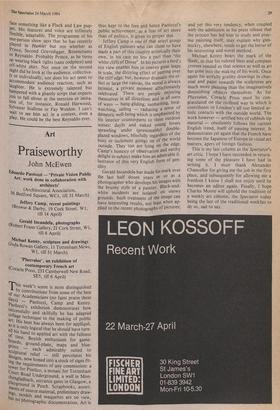Art
Praiseworthy
John McEwen
Eduardo Paolozzi — 'Private Vision Public Art: work done in collaboration with architects' (Architectural Association, 36 Bedford Square, WC I, till 31 March)
Jeffery Camp, recent paintings (Browse & Darby, 19 Cork Street, W 1, till 14 April) Gerald Incandela, photographs (Robert Fraser Gallery, 21 Cork Street, Wl, till 6 April) Michael Kenny, sculpture and drawings (Aida Rowan Gallery, 11 Tottenham Mews, WI, till 31 March) `Pluxvalue', an exhibition of contemporary French art (Coracle Press, 233 Camberwell New Road, SE5, till 6 April)
This week's scene is most distinguished by contributions from some of the best of our Academicians (no faint praise these days) — Paolozzi, Camp and Kenny. Paolozzi's exhibition demonstrates how successfully and skilfully he has adapted collage technique to the making of public art. His bent has always been for applique, so it is only logical that he should have turn- ed his hand to applied art with the fullness of time Boyish enthusiasm for game- boards, ground-plans, maps and blue- prints each admirably suited to sculptural relief — still percolates his designs, now honed into a stock of signs fit- ing the requirements of any commission: a tower for Pimlico, a mosaic for Tottenham Court Road Underground, a wall in Mon- chengladbach, entrance gates in Glasgow, a Playground in Pesch. Scrapbooks, assort- ments of source material, preliminary draw- ings, models and maquettes are on view, but no photographic documentation. Art is
thus kept to the fore and hence Paolozzi's public achievement, as a feat of art more than of politics, is given its proper due. •
Jeffery Camp is one of that select group of English painters who can claim to have made a part of this country artistically their own, in his case no less a part than 'the white cliffs of Dover'. In his pictures a bird's eye view enables him to convey great leaps in scale, the dizzying effect of peering over the cliff edge; but, however dramatic the ef- fect or large the canvas, the mood is always intimist, a private moment affectionately celebrated. There are people enjoying themselves in all directions and
in all sorts
of ways — hang-gliding, sunbathing, bird- watching, sailing — radiating a sense of domestic well-being which is emphasised by his interior counterparts to these outdoor scenes: daylit and naked young lovers sprawling under (presumably) double- glazed windows, blissfully regardless of the busy or inclement goings on of the world outside. They too are lying on the edge. Camp's honesty of observation and earthy delight in subject make him an admirable il- lustrator of this very English form of gen- tility.
Gerald Incandela has made his mark over the last half dozen years or so as a photographer who develops his images with the brushy style of a painter. Black-and- white incidents are . isolated on snowy grounds. Such treatment of the image can have interesting results, not least when ap- plied to the recent photographs of pictures; and yet this very tendency, when coupled with the admission in his press release that the process has led him to study and prac- tise painting itself, may explain why gim- mickry, elsewhere, tends to get the better of his interesting and novel method.
Michael Kenny bears the mark of the Slade, in that his rulered lines and compass crosses remind us that science as well as art has gone into the making of his work. Once again his artfully grubby drawings in char- coal and paint towards the sculptures are much more pleasing than the imaginatively diminishing objects themselves. As for Pluxvalue, Coracle Press must be con- gratulated on the civilised way in which it contributes to London's all too limited ar- tistic contacts with the outside world. The work however — artified bits of rubbish-tip material — obediently follows the current English trend, itself of passing interest. It demonstrates yet again that the French have become the Japanese of Europe in visual art matters, apers of foreign fashion.
This is my last column as the Spectator's art critic. I hope 1 have succeeded in return- ing some of the pleasure I have had in writing it. I must thank Alexander Chancellor for giving me the job in the first place, and subsequently for allowing me a freedom I know I shall not enjoy until he becomes an editor again. Finally, I hope Charles Moore will uphold the tradition of a weekly art column, the Spectator today being the last of the traditional weeklies to do so, sad to say.










































 Previous page
Previous page